为什么选用Flume
flume最主要的作用就是,实时读取服务器本地磁盘数据,将数据写入到HDFS。(最主流)
Flume架构
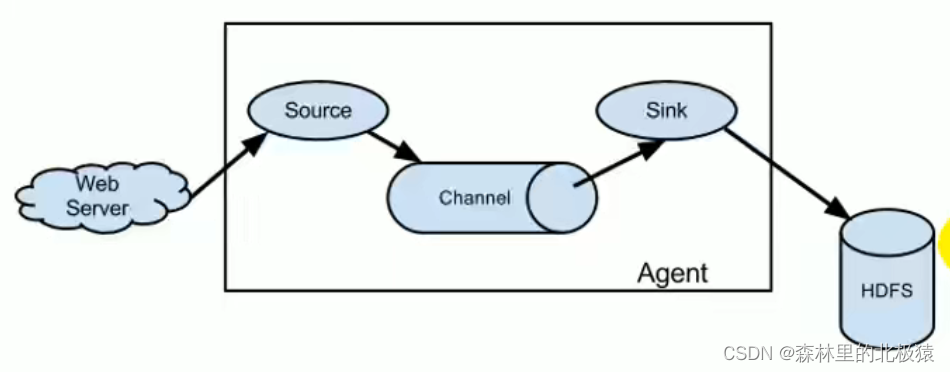
案例1
在flume下建立一个文件(文件命名一般都是source-flume-sink,见名见意)

# example.conf: A single-node Flume configuration
# Name the components on this agent
a1.sources = r1
a1.sinks = k1
a1.channels = c1
# Describe/configure the source
a1.sources.r1.type = netcat
a1.sources.r1.bind = localhost
a1.sources.r1.port = 44444
# Describe the sink
a1.sinks.k1.type = logger
# Use a channel which buffers events in memory
a1.channels.c1.type = memory
a1.channels.c1.capacity = 1000 //1000代表的是1000个事件
a1.channels.c1.transactionCapacity = 100 //一次最多传100个时间,这条要比上面的少
# Bind the source and sink to the channel
a1.sources.r1.channels = c1
a1.sinks.k1.channel = c1
要注意这里:
a1.sources.r1.channels = c1
a1.sinks.k1.channel = c1
这两行代表的这种意思
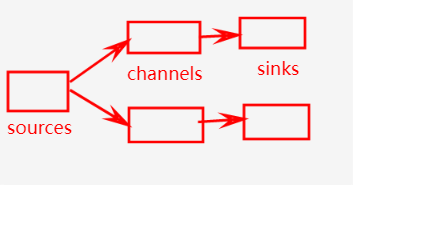
一个source能够发给多个channel,但是一个channel只能发给一个sink
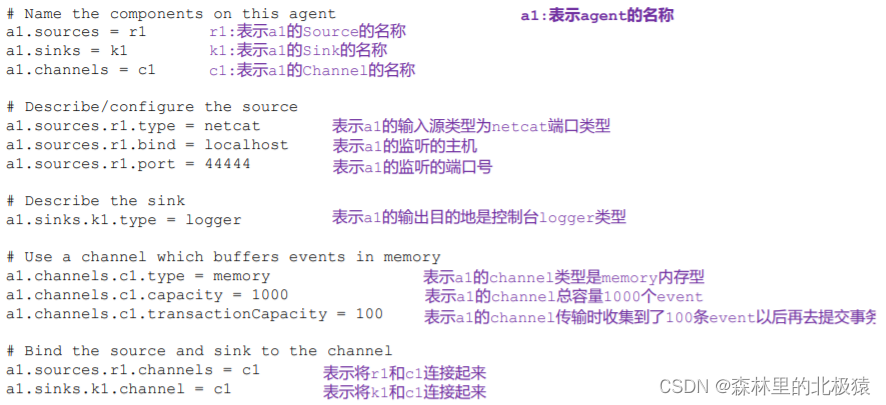
shell启动命令
//官网给的启动,提示
$ bin/flume-ng agent -n $agent_name -c conf -f conf/flume-conf.properties.template -Dflume.root.logger=INFO,console
//我的启动
bin/flume-ng agent -n a1 -c conf/ -f job/net-flume-logger.co -Dflume.root.logger=INFO,console
–conf/-c:表示配置文件存储在 conf/目录
–name/-n:表示给 agent 起名为 a1
–conf-file/-f:flume 本次启动读取的配置文件是在 job 文件夹下的 flume-telnet.conf
文件。
-Dflume.root.logger=INFO,console :-D 表示 flume 运行时动态修改 flume.root.logger
参数属性值,并将控制台日志打印级别设置为 INFO 级别。日志级别包括:log、info、warn、
error。

启动成功
使用 netcat 工具向本机的 44444 端口发送内容

在 Flume 监听页面观察接收数据情况

案例二(实时监控单个追加文件)
案例需求:实时监控 Hive 日志,并上传到 HDFS 中
实时读取本地文件到HDFS
基本步骤

实施步骤
在flume下的job目录下创建一个文件
vim flume-file-hdfs.conf
需要注意的是:
要想读取Linux中文件,就得Linux命令的规则执行命令。
由于Hive的日志是在Linux系统中,所以读取文件的类型选择为exec(也就是executor 执行者 的意思)。
表示执行Linux命令来读取文件
配置信息如下
查看flume链接
选择用户指南
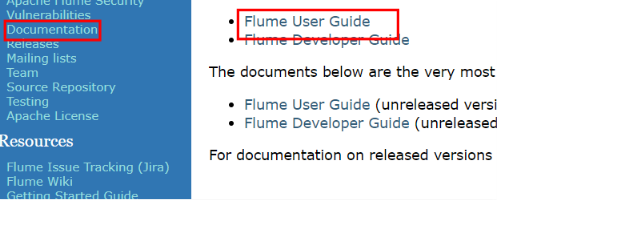
因为我们要上传文件到HDFS中,也就是sink端为HDFS,我们可以搜hdfs sink 查看需要什么配置参数
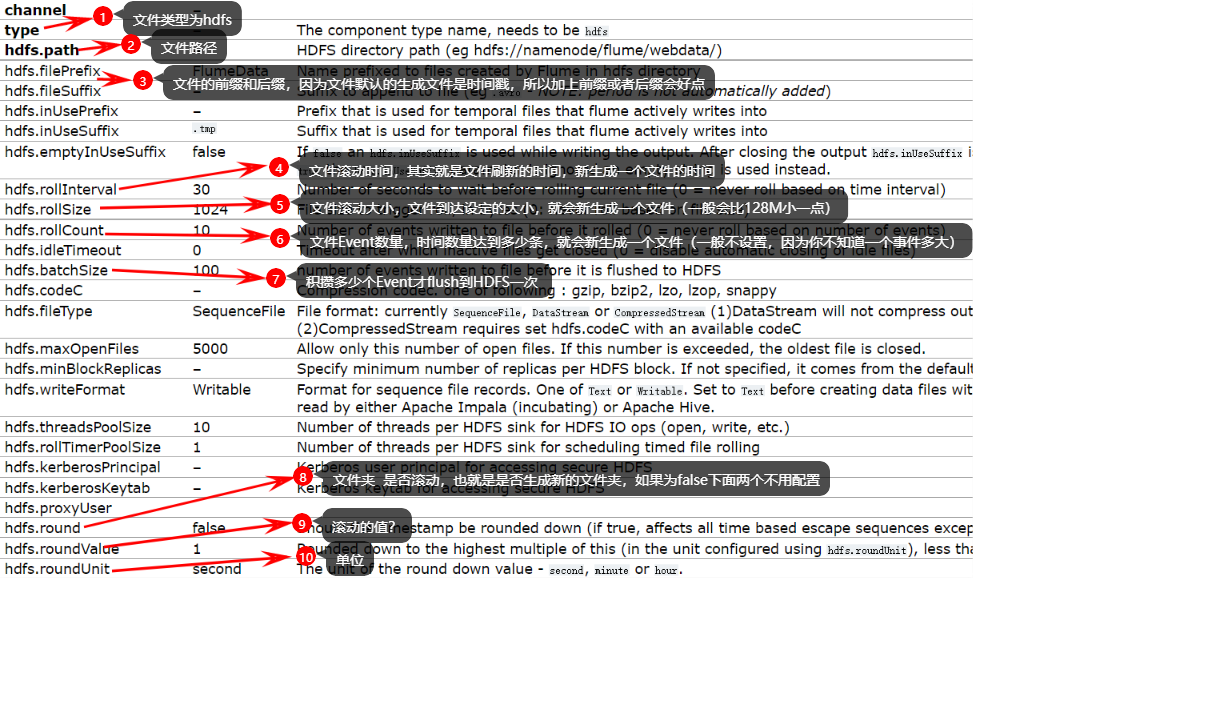
# Name the components on this agent
a2.sources = r2
a2.sinks = k2
a2.channels = c2
# Describe/configure the source
# 执行文件的类型,exec执行Linux命令,查看文件
a2.sources.r2.type = exec
# 文件的执行命令(这里hive.log如果没有特别配置默认在 /tmp/root/hive.log)
a2.sources.r2.command = tail -F /opt/module/hive/logs/hive.log
a2.sources.r2.shell = /bin/bash -c
# Describe the sink
a2.sinks.k2.type = hdfs
# 这里创建目录(不是文件)
a2.sinks.k2.hdfs.path = hdfs://hadoop102:9000/flume/%Y%m%d/%H
#上传文件的前缀
a2.sinks.k2.hdfs.filePrefix = logs-
#是否按照时间滚动文件夹
a2.sinks.k2.hdfs.round = true
#多少时间单位创建一个新的文件夹
a2.sinks.k2.hdfs.roundValue = 1
#重新定义时间单位
a2.sinks.k2.hdfs.roundUnit = hour
#是否使用本地时间戳,这里一定要true,因为上面我们用到了时间
a2.sinks.k2.hdfs.useLocalTimeStamp = true
#积攒多少个 Event 才 flush 到 HDFS 一次
a2.sinks.k2.hdfs.batchSize = 100
#设置文件类型,可支持压缩
a2.sinks.k2.hdfs.fileType = DataStream
#多久生成一个新的文件
a2.sinks.k2.hdfs.rollInterval = 30
#设置每个文件的滚动大小
a2.sinks.k2.hdfs.rollSize = 134217700
#文件的滚动与 Event 数量无关
a2.sinks.k2.hdfs.rollCount = 0
# Use a channel which buffers events in memory
a2.channels.c2.type = memory
a2.channels.c2.capacity = 1000
a2.channels.c2.transactionCapacity = 100
# Bind the source and sink to the channel
a2.sources.r2.channels = c2
a2.sinks.k2.channel = c2
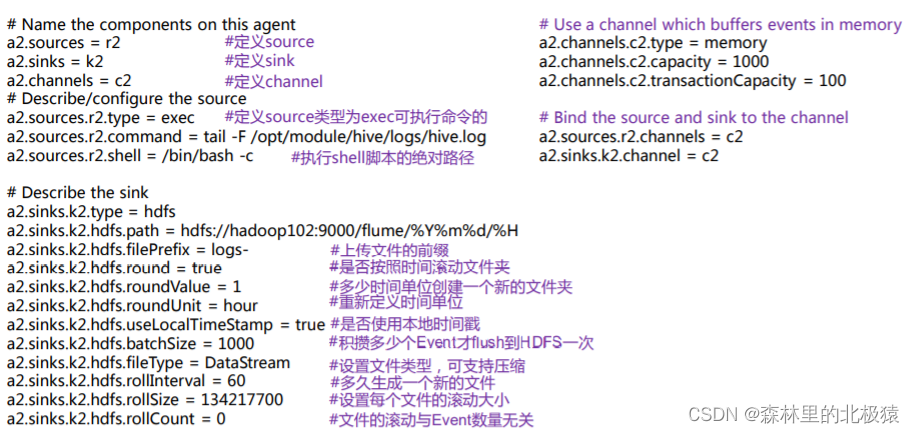
开始测试
启动flume任务

启动hive,在hive里面操作,查看hdfs
文件没有刷新前后缀是tmp,只要达到你设定的条件就会变成文件,例如30s,128M,等等


实时监控目录下多个新文件
使用 Flume 监听整个目录的文件,并上传至 HDFS,了解断点续传
需求分析
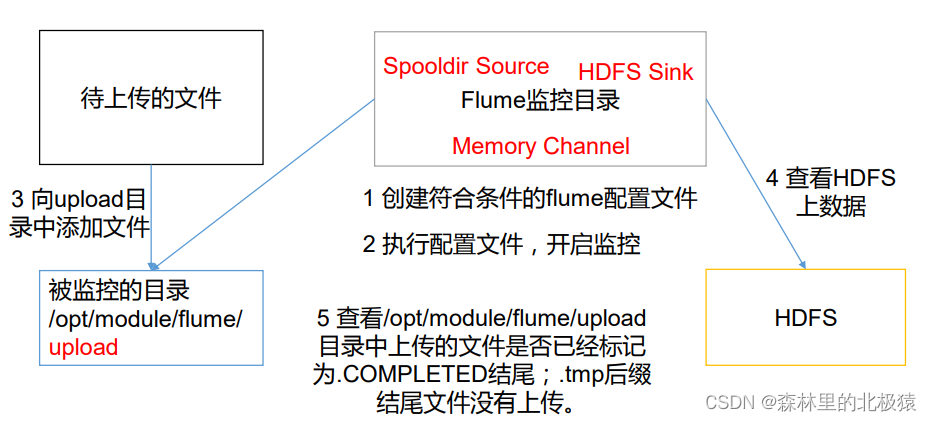
实现步骤
- 创建文件夹
[root@hadoop01 apache-flume-1.9.0-bin]# mkdir upload
- 在job目录下创建文件flume-dir-hdfs.conf
内容如下(配置文件)
a3.sources = r3
a3.sinks = k3
a3.channels = c3
# Describe/configure the source
a3.sources.r3.type = spooldir
a3.sources.r3.spoolDir = /opt/module/flume/upload
a3.sources.r3.fileSuffix = .COMPLETED
a3.sources.r3.fileHeader = true
#忽略所有以.tmp 结尾的文件,不上传
a3.sources.r3.ignorePattern = ([^ ]*\.tmp)
# Describe the sink
a3.sinks.k3.type = hdfs
a3.sinks.k3.hdfs.path =
hdfs://hadoop102:9000/flume/upload/%Y%m%d/%H
#上传文件的前缀
a3.sinks.k3.hdfs.filePrefix = upload-
#是否按照时间滚动文件夹
a3.sinks.k3.hdfs.round = true
#多少时间单位创建一个新的文件夹
a3.sinks.k3.hdfs.roundValue = 1
#重新定义时间单位
a3.sinks.k3.hdfs.roundUnit = hour
#是否使用本地时间戳
a3.sinks.k3.hdfs.useLocalTimeStamp = true
#积攒多少个 Event 才 flush 到 HDFS 一次
a3.sinks.k3.hdfs.batchSize = 100
a3.sinks.k3.hdfs.fileType = DataStream
#多久生成一个新的文件
a3.sinks.k3.hdfs.rollInterval = 60
#设置每个文件的滚动大小大概是 128M
a3.sinks.k3.hdfs.rollSize = 134217700
#文件的滚动与 Event 数量无关
a3.sinks.k3.hdfs.rollCount = 0
# Use a channel which buffers events in memory
a3.channels.c3.type = memory
a3.channels.c3.capacity = 1000
a3.channels.c3.transactionCapacity = 100
# Bind the source and sink to the channel
a3.sources.r3.channels = c3
a3.sinks.k3.channel = c3

- 运行文件
[root@hadoop01 apache-flume-1.9.0-bin]# bin/flume-ng agent -n a3 -c conf -f job/flume-dir-hdfs.conf
- 向 upload 文件夹中添加文件
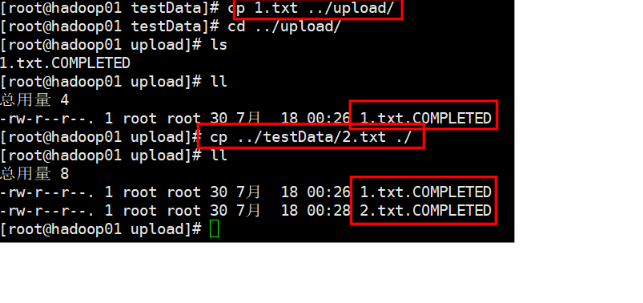

上传成功后会出现以
.COMPLETED结尾的文件夹,说明flume已经将此文件上传了,以后不再监控。
所以,
不要在监控的目录中创建和修改文件。
监控的文件会500毫秒扫描一次。
实时监控目录下的多个追加文件
案例需求
使用 Flume 监听整个目录的实时追加文件,并上传至 HDFS

实现步骤
- 配置参数
这里我是打印到控制台上,去hdfs也是同上面一样
# Name the components on this agent
a1.sources = r1
a1.sinks = k1
a1.channels = c1
# Describe/configure the source
a1.sources.r1.type = TAILDIR
a1.sources.r1.filegroups = f1
a1.sources.r1.filegroups.f1 = /export/servers/apache-flume-1.9.0-bin/testData/.*.txt
a1.sources.r1.positionFile = /export/servers/apache-flume-1.9.0-bin/position/position.json
# Describe the sink
a1.sinks.k1.type = logger
# Use a channel which buffers events in memory
a1.channels.c1.type = memory
a1.channels.c1.capacity = 1000
a1.channels.c1.transactionCapacity = 100
# Bind the source and sink to the channel
a1.sources.r1.channels = c1
a1.sinks.k1.channel = c1

2. 启动监管命令
[root@hadoop01 apache-flume-1.9.0-bin]# bin/flume-ng agent -n a1 -c conf/ -f ./job/flume-taildir-hdfs.conf -Dflume.root.logger=INFO,console
- 向文件夹中追加内容

Taildir Source 维护了一个 json 格式的 position File,其会定期的往 position File
中更新每个文件读取到的最新的位置,因此能够实现断点续传。Position File 的格式如下:
{“inode”:2496272,“pos”:12,“file”:“/opt/module/flume/files/file1.txt”}
{“inode”:2496275,“pos”:12,“file”:“/opt/module/flume/files/file2.txt”}
flume事务
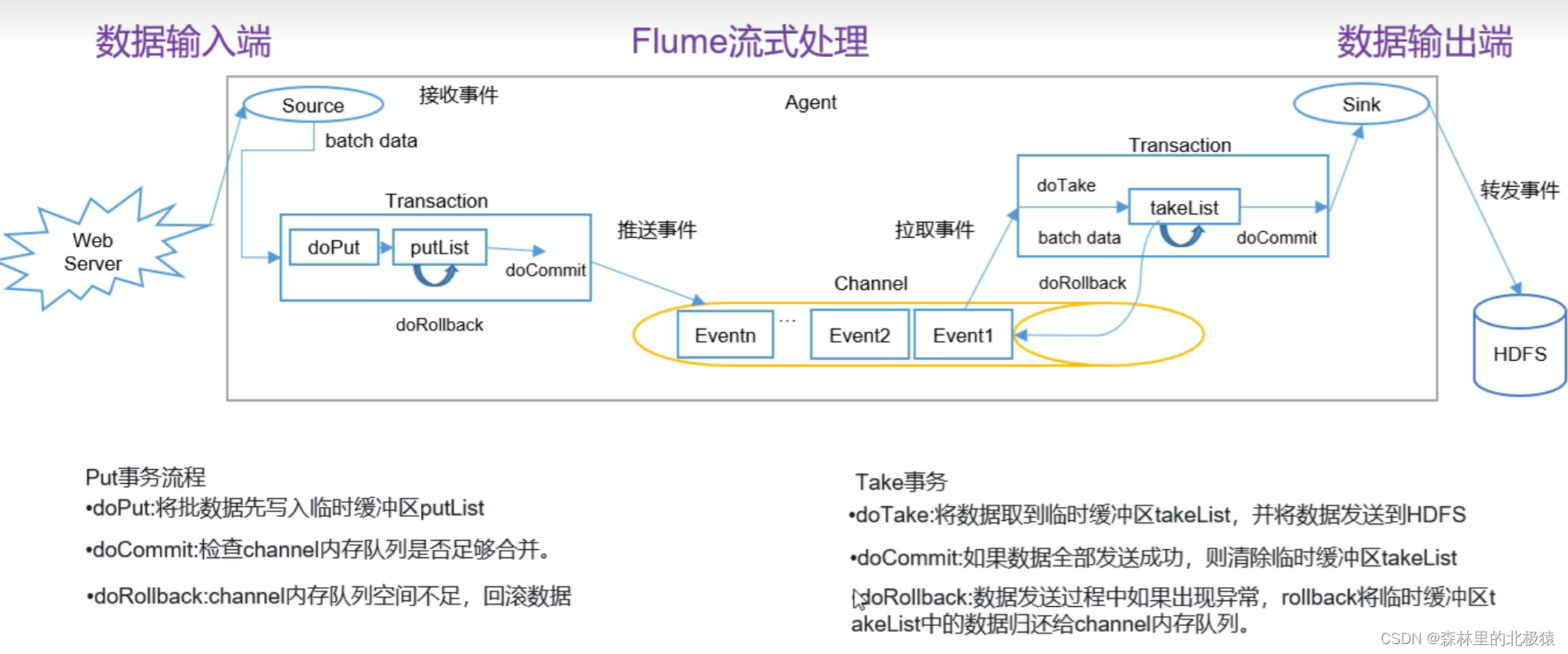
Flume Agent内部原理
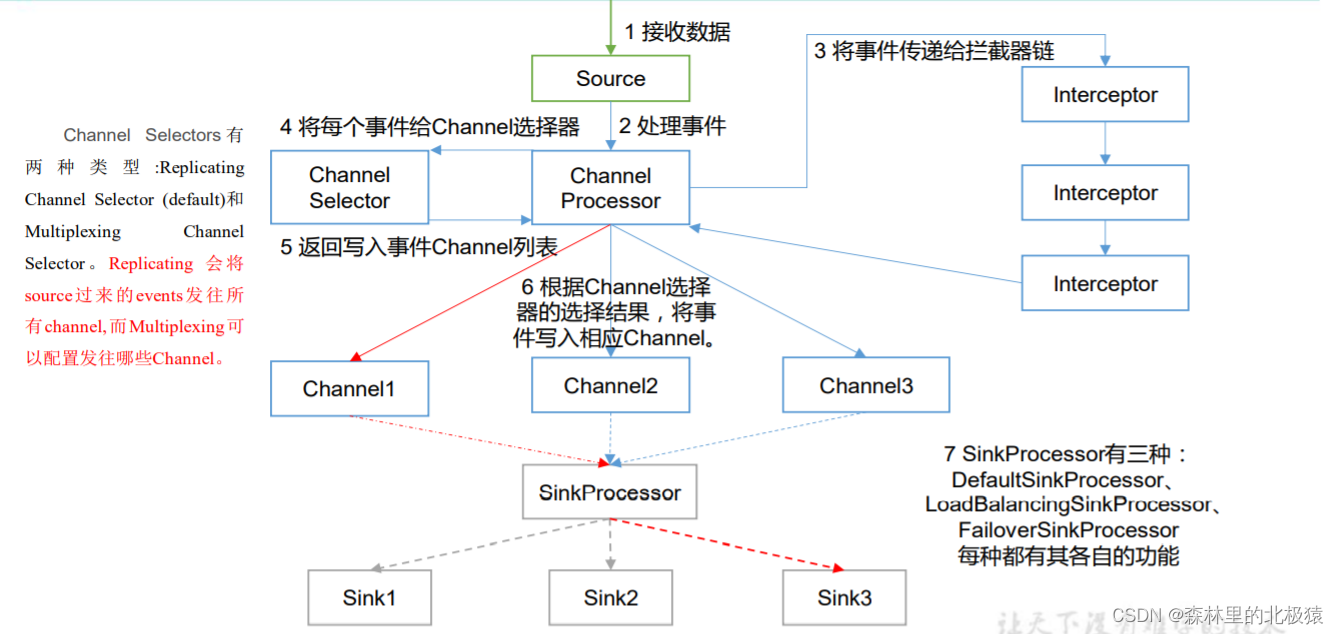
1)ChannelSelector
ChannelSelector 的作用就是选出 Event 将要被发往哪个 Channel。其共有两种类型,
分别是 Replicating(复制)和 Multiplexing(多路复用)。
ReplicatingSelector 会将同一个 Event 发往所有的 Channel,Multiplexing 会根据相
应的原则,将不同的 Event 发往不同的 Channel。
2)SinkProcessor
SinkProcessor 共 有 三 种 类 型 , 分 别 是 DefaultSinkProcessor 、
LoadBalancingSinkProcessor 和 FailoverSinkProcessor
DefaultSinkProcessor 对 应 的 是 单 个 的 Sink , LoadBalancingSinkProcessor 和
FailoverSinkProcessor 对应的是 Sink Group,LoadBalancingSinkProcessor 可以实现负
载均衡的功能,FailoverSinkProcessor 可以实现故障转移的功能。
复用和多路复用

步骤
-
在flume/job/下创建文件夹group1
在flume/testData下创建文件夹flume3和hive.log
在flume/position下创建文件position2.json -
创建flume-1,在flume/job/group1下创建文件flume-file-flume.conf,配置如下:
#name
a1.sources = r1
a1.sinks = k1 k2
a1.channels = c1 c2
#source
a1.sources.r1.type = TAILDIR
a1.sources.r1.filegroups = f1
a1.sources.r1.filegroups.f1 = /export/servers/apache-flume-1.9.0-bin/testData/hive.log
a1.sources.r1.positionFile = /export/servers/apache-flume-1.9.0-bin/position/position1.json
#sink
a1.sinks.k1.type = avro
a1.sinks.k1.hostname = hadoop01
a1.sinks.k1.port = 4141
a1.sinks.k2.type = avro
a1.sinks.k2.hostname = hadoop01
a1.sinks.k2.port = 4142
#channel
a1.channels.c1.type = memory
a1.channels.c1.capacity = 1000
a1.channels.c1.transactionCapacity = 100
a1.channels.c2.type = memory
a1.channels.c2.capacity = 1000
a1.channels.c2.transactionCapacity = 100
#bind
a1.sources.r1.channels = c1 c2
a1.sinks.k1.channel = c1
a1.sinks.k2.channel = c2
- 创建flume-2,在flume/job/group1下创建文件flume-flume-hdfs.conf,配置如下:
# Name the components on this agent
a2.sources = r1
a2.sinks = k1
a2.channels = c1
#source
a2.sources.r1.type = avro
a2.sources.r1.bind = hadoop01
a2.sources.r1.port = 4141
#sink
a2.sinks.k1.type = hdfs
a2.sinks.k1.hdfs.path = hdfs://hadoop01:9000/flume2/%Y%m%d/%H
#上传文件的前缀
a2.sinks.k1.hdfs.filePrefix = flume2-
#是否按照时间滚动文件夹
a2.sinks.k1.hdfs.round = true
#多少时间单位创建一个新的文件夹
a2.sinks.k1.hdfs.roundValue = 1
#重新定义时间单位
a2.sinks.k1.hdfs.roundUnit = hour
#是否使用本地时间戳
a2.sinks.k1.hdfs.useLocalTimeStamp = true
#积攒多少个 Event 才 flush 到 HDFS 一次
a2.sinks.k1.hdfs.batchSize = 100
#设置文件类型,可支持压缩
a2.sinks.k1.hdfs.fileType = DataStream
#多久生成一个新的文件
a2.sinks.k1.hdfs.rollInterval = 30
#设置每个文件的滚动大小大概是 128M
a2.sinks.k1.hdfs.rollSize = 134217700
#文件的滚动与 Event 数量无关
a2.sinks.k1.hdfs.rollCount = 0
# Describe the channel
a2.channels.c1.type = memory
a2.channels.c1.capacity = 100
a2.channels.c1.transactionCapacity = 100
# Bind the source and sink to the channel
a2.sources.r1.channels = c1
a2.sinks.k1.channel = c1
- 创建flume-2,在flume/job/group1下创建文件flume-flume-file.conf,配置如下:
# Name the components on this agent
a3.sources = r1
a3.sinks = k1
a3.channels = c2
# Describe/configure the source
a3.sources.r1.type = avro
a3.sources.r1.bind = hadoop01
a3.sources.r1.port = 4142
# Describe the sink
a3.sinks.k1.type = file_roll
a3.sinks.k1.sink.directory = /export/servers/apache-flume-1.9.0-bin/testData/flume3/
# Describe the channel
a3.channels.c2.type = memory
a3.channels.c2.capacity = 1000
a3.channels.c2.transactionCapacity = 100
# Bind the source and sink to the channel
a3.sources.r1.channels = c2
a3.sinks.k1.channel = c2
提示:输出的本地目录必须是已经存在的目录,如果该目录不存在,并不会创建新的目录。
5. 执行文件
bin/flume-ng agent -n a1 -c conf/ -f job/group1/flume-file-flume.conf
bin/flume-ng agent -n a2 -c conf/ -f job/group1/flume-flume-hdfs.conf
bin/flume-ng agent -n a3 -c conf/ -f job/group1/flume-flume-file.conf
- 测试

hdfs创建文件了

里面内容为
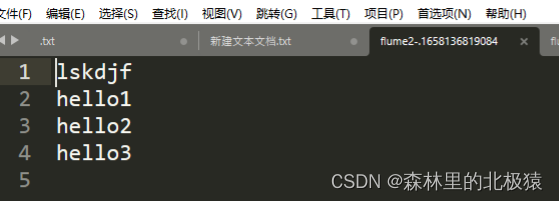
在磁盘中,文件生成

故障转移
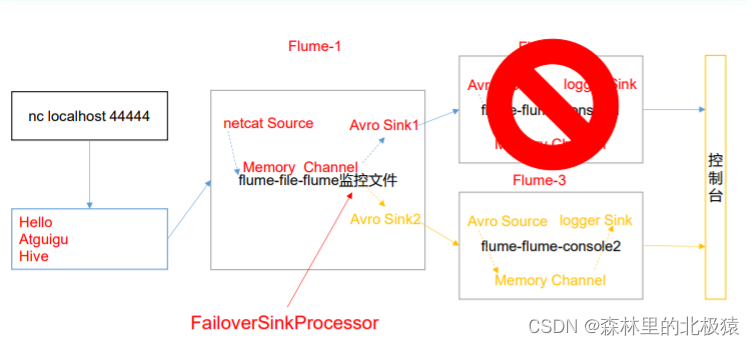
配置文件
- 在Linux中创建好文件

- flume1.conf的配置如下
# Name the components on this agent
a1.sources = r1
a1.channels = c1
a1.sinkgroups = g1
a1.sinks = k1 k2
# Describe/configure the source
a1.sources.r1.type = netcat
a1.sources.r1.bind = localhost
a1.sources.r1.port = 44444
a1.sinkgroups.g1.processor.type = failover
a1.sinkgroups.g1.processor.priority.k1 = 5
a1.sinkgroups.g1.processor.priority.k2 = 10
a1.sinkgroups.g1.processor.maxpenalty = 10000
# Describe the sink
a1.sinks.k1.type = avro
a1.sinks.k1.hostname = hadoop01
a1.sinks.k1.port = 4141
a1.sinks.k2.type = avro
a1.sinks.k2.hostname = hadoop01
a1.sinks.k2.port = 4142
# Describe the channel
a1.channels.c1.type = memory
a1.channels.c1.capacity = 1000
a1.channels.c1.transactionCapacity = 100
# Bind the source and sink to the channel
a1.sources.r1.channels = c1
a1.sinkgroups.g1.sinks = k1 k2
a1.sinks.k1.channel = c1
a1.sinks.k2.channel = c1
- flume2.conf的配置如下
# Name the components on this agent
a2.sources = r1
a2.sinks = k1
a2.channels = c1
# Describe/configure the source
a2.sources.r1.type = avro
a2.sources.r1.bind = hadoop01
a2.sources.r1.port = 4141
# Describe the sink
a2.sinks.k1.type = logger
# Describe the channel
a2.channels.c1.type = memory
a2.channels.c1.capacity = 1000
a2.channels.c1.transactionCapacity = 100
# Bind the source and sink to the channel
a2.sources.r1.channels = c1
a2.sinks.k1.channel = c1
- flume3.conf的配置如下
# Name the components on this agent
a3.sources = r1
a3.sinks = k1
a3.channels = c2
# Describe/configure the source
a3.sources.r1.type = avro
a3.sources.r1.bind = hadoop01
a3.sources.r1.port = 4142
# Describe the sink
a3.sinks.k1.type = logger
# Describe the channel
a3.channels.c2.type = memory
a3.channels.c2.capacity = 1000
a3.channels.c2.transactionCapacity = 100
# Bind the source and sink to the channel
a3.sources.r1.channels = c2
a3.sinks.k1.channel = c2
- 分别运行
bin/flume-ng agent -n a1 -c conf/ -f job/group2/flume1.conf
bin/flume-ng agent -n a2 -c conf/ -f job/group2/flume2.conf -Dflume.root.loogger=INFO,console
bin/flume-ng agent -n a3 -c conf/ -f job/group2/flume3.conf -Dflume.root.loogger=INFO,console
- 在netcat中发送消息,flume3先收到,无论我怎么发都是flume3收到

7. 把flume3停掉(模拟挂掉的场景)
使用netcat发送消息,可以看到在flume2出现

负载均衡
- 这里与上面操作其实,类似,我们只需要更改一下flume1文件就ok
- 配置文件如下
# Name the components on this agent
a1.sources = r1
a1.channels = c1
a1.sinkgroups = g1
a1.sinks = k1 k2
# Describe/configure the source
a1.sources.r1.type = netcat
a1.sources.r1.bind = localhost
a1.sources.r1.port = 44444
a1.sinkgroups.g1.processor.type = load_balance
a1.sinkgroups.g1.processor.backoff = true
a1.sinkgroups.g1.processor.selector = random
# Describe the sink
a1.sinks.k1.type = avro
a1.sinks.k1.hostname = hadoop01
a1.sinks.k1.port = 4141
a1.sinks.k2.type = avro
a1.sinks.k2.hostname = hadoop01
a1.sinks.k2.port = 4142
# Describe the channel
a1.channels.c1.type = memory
a1.channels.c1.capacity = 1000
a1.channels.c1.transactionCapacity = 100
# Bind the source and sink to the channel
a1.sources.r1.channels = c1
a1.sinkgroups.g1.sinks = k1 k2
a1.sinks.k1.channel = c1
a1.sinks.k2.channel = c1
运行,随机在flume2和flume3中传输数据
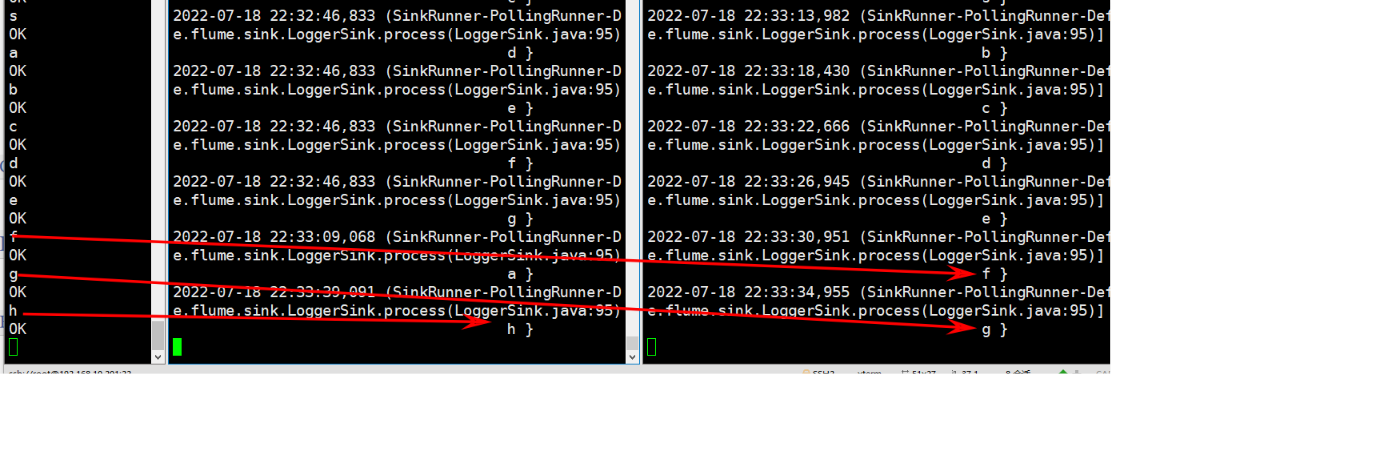
聚合
看尚硅谷文档,配置思想一样的





















 2912
2912











 被折叠的 条评论
为什么被折叠?
被折叠的 条评论
为什么被折叠?








